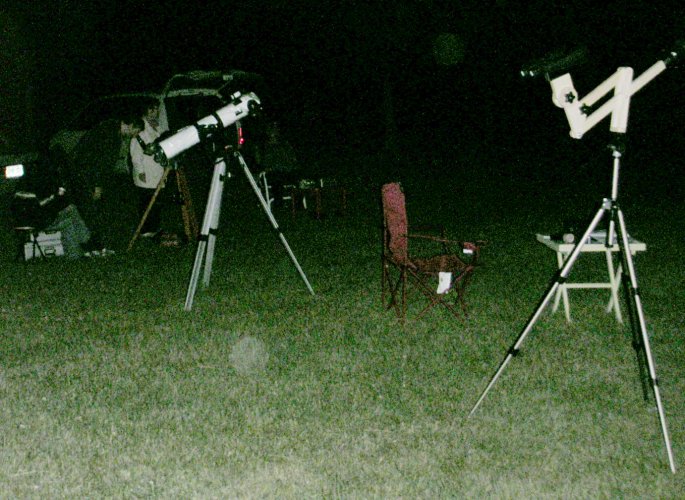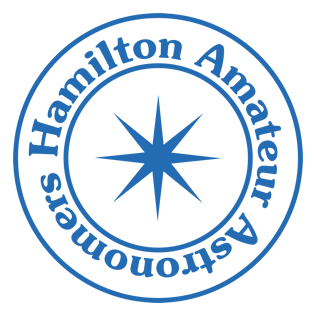Observing report, June 10, 2007
5 of us arrived at Binbrook a bit before about 9pm. The gate was still open so i went in.
A ranger followed me about 10 minutes later and i explained i was with the astronomy club.
Some people came by on foot with their dogs, and then continued on their walk. I had arrived first and set up down at the beach but everyone else thought the top of the hill was much better. Not one to reject experience, i carried my scope and binoculars up the hill and moved the car.
My first project was the alignment of my finder scope. I used the distant trees, but it turned out that the trees are fractal in nature and i actually had aligned my finderscope with a different bunch of leaves that looked like mickey mouse.
Once i established that venus was nowhere to be seen in the scope, i repeated it with a more distinctive bunch of branches and had it perfectly aligned. It made a big difference since i could now use a high power eyepiece and verify with the finderscope that all was well.
First there was a fine sunset, with pastel hues of pink and purple. Venus and Saturn were out in the twilight, and we were able to bring them into view, and even see titan, long before the constellations were out. Before long we also spotted Jupiter from behind some trees near the horizon. John pointed out to us that we could now see 4 planets, almost half the solar system. I fell for that one and asked which was the fourth planet. “You’re standing on it”.
The space station was due to cross the sky at about 10:36 pm. In spite of some low
clouds we were able to pick it up with unaided eyes, and also find it in binoculars,
although it occurs to me that an orbital mount angle might be a handy way to track it
without all kinds of hand adjustment. John had printed out a chart of several expected satellites with timing and path predictions.
We saw several other satellites, but could not follow them all the way across the sky. They seemed to be bright for a few seconds and then dim down almost to invisibility in the skyglow over Hamilton.
We went over to the water’s edge and watched Venus reflected in the water. A fine meteor
shot past Venus and 2 of us saw it. Back up the hill after that.
We then toured the sky for globular and open clusters, M53, M57. Exchanging views in various scopes and binoculars.
I used my star charts and the EH to locate Vesta, first in binoculars, next in the spotting scope of my newtonian and finally in the scope itself. Star charts in the binoculars showed it to be a third ‘star’ near 2 charted stars of similar brightness.
The transit of Io across Jupiter was due to begin at 11:40 PM. We watched as it became not more than a bump on Jupiter, and then eventually we were able to see the shadow on Jupiter,
as a small black dot.
It was a nice evening, but there was almost no wind. In spite of that, we got no problems from dew except for Jackie’s scope which got packed up around midnight. She remained to look through John’s 80 mm refractor.

I tried to locate M4 in my scope. Although i could pick it up in the binoculars, it was much harder to find in the finderscope. Eventually i found it.
The 4.5 inch Newtonian served me well, again, but had some problems too… for one thing, there was not a very rich star field along with Vesta. I am spoiled by my binoculars.
So with the widest eyepiece, all i really had in the eyepiece was Vesta. The lack of a RA motor for it is one inconvenience, and the other is that there’s a lot of backlash and play in the motors, such that nudging the scope or turning the focuser will reposition it.
Also the focuser mechanism is not silky smooth, and this makes it harder to adjust the focus for planets.
John tried Jackie’s bino-viewer on his Orion 80, and the star fields were nice and dark
and sharp. John was positively delighted with the improvement in comfort, detail and ease of use with the bino-viewer. An additional bonus is that when you refer to the orientation of objects in the field of view, clock hours can make sense, since all observers will be in the same orientation. This is not the case with a single eyepiece.
John then attached a 2 inch diagonal and one of his wide field eyepieces. We looked at several nebulae including M16 and M17. John demonstrated that with a 2 inch diagonal, they could both be seen in the same field of view. This is possible on a shorted refractor but not with a SCT.
We returned to the Jupiter transit several times, while in the meantime seeking out Messier
objects against the rich background of the milky way in Saggitarius.
Compared to wintertime, it was balmy. I did not even have to do up my jacket, although
some people were a bit colder. A few hand warmers helped immensely. The weather was perfect, and the seeing was steady, the wind was not buffeting us or the scopes, and we remained there till after 2 am, then packed up and headed for home.
Once again it was worth the drive to Binbrook.
Clear skies!
